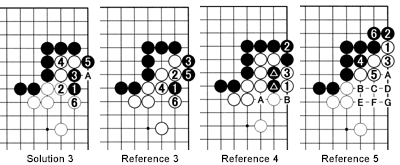Although go has a long history,
By Rob Van Zeijst
Although go has a long history, it is still evolving. The level of the top players also is improving. Why is this? One reason is that the number of professionals has increased and many of the top players were exposed to go at a young age and took to the game with greater fervor. Secondly, more information is available, thanks to the Internet. Another reason is cultural. At one time, the game was played at a high level mainly in Japan. Nowadays, the game is played at such a level in South Korea, China, Taiwan, the United States and Europe. All these areas have professionals with their own, unique cultural outlook and view of the game.
Hit-under tesuji
We have already discussed double sente moves, which expand your own territory while reducing that of your opponent. The hit-under tesuji may expand your arsenal in this area.
Diagram 1: With 1, White hits under Black's stone, a tesuji that may work depending on the surrounding stones. In this case, Black is forced to play at 2 and 4 and White has succeeded in expanding his own territory while reducing Black's in sente.
Diagram 2: What happens if Black cuts with 2? In that case, White would cut with 3. If Black tries to capture with 4, White cuts with 5 in sente, because Black must answer with 6. Next, if the ladder is good, White may play at A to capture two black stones. However, even if the ladder is unfavorable, White may play at B, followed by black C and white D. There are various possibilities for White to exploit Black's weaknesses.
Diagram 3: If Black does not defend properly against the possible cut at 5 and plays another large endgame move, such as 4, what happens then? White would then cut at 5. If Black plays at 6 and 8, white 9 puts him on the spot. Black cannot play 10 at A to fill in a crucial liberty, because White would cut at 10 and then capture two black stones with 11. In other words, Black really needs to defend with 4 in Diagram 1.

Solutions to last week's problems
Solution 1: In response to Black's oki-tesuji placement of 1, white 2 is a mistake. Black can now play at 3 to start a ko. Of course, White may take the ko first with 4, but if he loses it, his entire corner will die. On the other hand, if White wins the ko, the result is only a few points better than in Reference 1, which provides the correct answer for White. Incidentally, a ko in which one person has a lot at stake and the opponent has almost nothing to lose is called a hanami ko, which translates as "flower-viewing" ko.
Reference 1: Therefore, White should play at 2. This allows Black to connect with 3 in sente as White needs to answer with 4, but at least he does not put his own stones in danger.
Solution 2: Black 1 is the correct move. White is forced to reply with 2 and 4. Black will make a few points in sente. How many?
Reference 2: If Black plays at 1, White can play at 2, forcing Black to connect with 3, before White defends with 4. The difference in territory is three points compared to Solution 2.

Solution 3: The oki-tesuji of 1 is a great move for Black. White's best response is to connect at 2, allowing Black to connect with 3 and 5. After 6, Black can either connect at A or play tenuki (elsewhere).
Reference 3: Can White first play at 2? Yes, but Black has a good move at 3 forcing White to connect at 4. Next, Black would connect at 5. After 6, White has less territory than in Solution 3.
Reference 4: Playing tenuki after 6 in Solution 3 may seem strange. Let's have a reality check. If White plays at 1 and 3 to capture three stones, he has six points, including A and B.
Reference 5: However, if Black had not done anything at all, White would have played at 1 and 3 in sente. Black 4 is a good forcing move, but in the end, Black has to defend with 6. As you can see, White has seven points (A through G), while Black's territory is two points smaller (at 2 and 6). The difference is 1 + 2 = 3 points. Therefore, Solution 3 is worth three points in sente, even if Black sacrifices two stones later.

Problems

Problem 1: How can White expand his territory and reduce Black's at the same time?
Problem 2: This is a problem for more advanced players. White can play 1 through 4 in sente. However, at an earlier stage, if it had been Black's move, how could he have prevented this? Hint: Use your knowledge of oki-tesuji.
